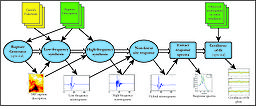Broadband Platform v11.2.3
The SCEC Broadband Platform is a software system which generates 0-10 Hz seismograms for historical and scenario earthquakes in California.
Contents
Overview
The goal of the SCEC Broadband Simulation Platform is to generate broadband (0-10 Hz) ground motions for earthquakes using deterministic low-frequency and stochastic high-frequency simulations. The SCEC Broadband Platform is a collaborative software development project involving SCEC researchers, graduate students, and the SCEC/CME software development group. SCEC scientific groups have contributed modules to the Broadband Platform including rupture generation, low-frequency deterministic seismogram synthesis, high-frequency stochastic seismogram synthesis, and non-linear site effects. These complex scientific codes have been integrated into a system that supports easy on-demand computation of broadband seismograms. The SCEC Broadband Platform is designed to be used by both scientific and engineering researchers with some experience interpreting ground motion simulations.
Users may calculate broadband seismograms for both historical earthquakes (validation events including Northridge, Loma Prieta, and Landers) and user-defined earthquakes. The platform produces a variety of data products, including broadband seismograms, rupture visualizations, and goodness-of-fit plots. Users can install the platform on their own machine, verify that it is installed correctly, and run their own simulations on demand without requiring knowledge of any of the code involved. Users may run a validation event, supply their own simple source description, or provide a rupture description in SRF format. Users may specify their own list of stations or use a provided list. Currently the platform supports stations and events in Southern California, the Bay Area, and the Mojave. Users may select among various codebases for rupture generation, low-frequency synthesis, high-frequency synthesis, and incorporation of site effects, with the option of running a goodness-of-fit comparison against observed or simulated seismograms. These codes have been validated against recorded ground motions from real events.
The Broadband Platform was implemented using software development best practices, including version control, user documentation, acceptance tests, and formal releases, with the aim of ease of installation and use.
Current Release
The current version of the Broadband Platform is v11.1.
Dependencies
Broadband has the following dependencies:
- Python 2.5+ with
- Intel compilers
and the following optional dependencies for additional functionality:
- GMT (for plotting)
- Matlab
Source code
Broadband source (Python scripts, source code, unit and acceptance tests) (.tgz, 75 MB): bbp_src-v11.01.tgz
md5sum: bbp_src-v11.01.tgz.md5
Data
Broadband data (Green's Functions, velocity model) (.tgz, 2.8 GB): bbp_data-v11.1.tgz
md5sum: bbp_data-v11.1.tgz.md5
Documentation
User Guide (includes installation instructions) (PDF, 239 KB): Broadband User Guide v11.1.0
Supporting Materials
Broadband poster from AGU 2010 (PDF, 882 KB)
Broadband overview talk from SC10 (PPT, 3.7 MB)
Technical diagrams of Broadband module relationships (PPTX, 16 KB)
Development version
If you're interested in working with the latest development version of the platform, you can check it out from
svn co https://source.usc.edu/svn/broadband/trunk
Details about working with the development version are provided in the User Guide.
Help
For assistance with the Broadband Platform, you may
- Browse and submit new tickets at Broadband Trac site
- Email support @ scec.org with specific questions
License
This software is released under the following license agreement with provided disclaimers: Broadband License
Release History
11.1.0 - January 2011 - Initial release.
See Also
References
- Graves, R. W. and A. Pitarka (in press). “Broadband Ground-Motion Simulation Using a Hybrid Approach.” Bull. Seis. Soc. Am.
- Mai, P.M., W. Imperatori, and K.B. Olsen (in press). “Hybrid broadband groundmotion simulations: combining long-period deterministic synthetics with high frequency multiple S-to-S back-scattering.” Bull. Seis. Soc. Am.
- Schmedes, J., R. J. Archuleta, and D. Lavallée (2010). “Correlation of earthquake source parameters inferred from dynamic rupture simulations.” J. Geophys. Res., 115, B03304, doi:10.1029/2009JB006689
